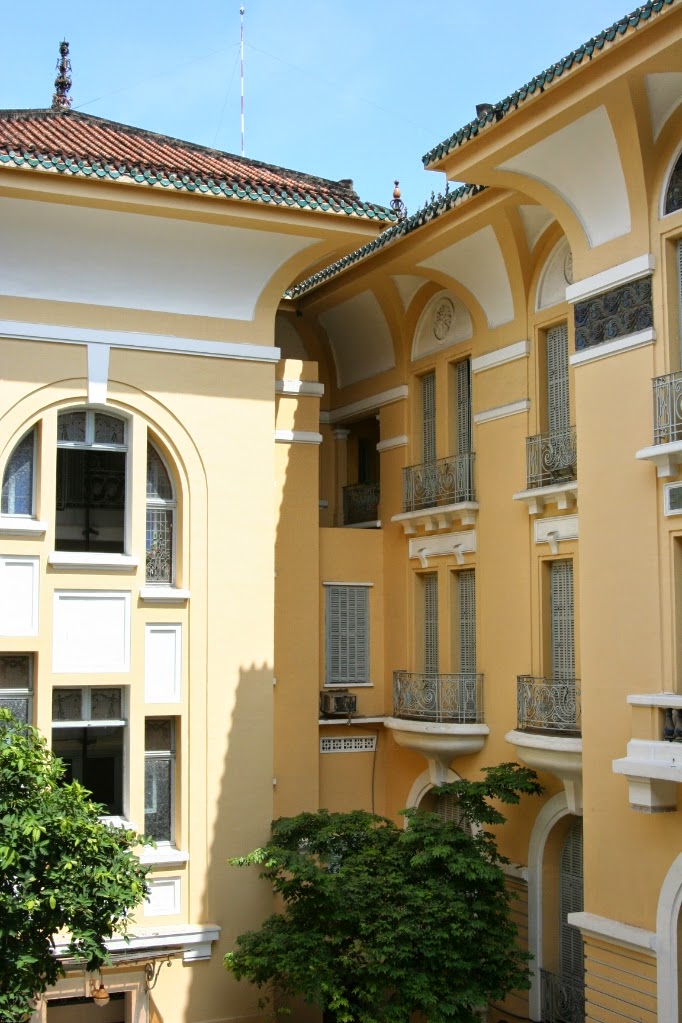Back in the city, we took advantage of what it has to offer and set out for the Ho Chi Minh Museum of Fine Arts.
On our way, we began our art appreciation by walking through the Tau Dan park sculptures. These are an eclectic collection, including a bust of Beethoven, a soldier, what appears to be a monkey riding a buffalo and various abstract female forms.
We also dropped into the Mariamman Hindu temple. This temple is dedicated to the goddess of rain and her many forms surround the inside of the central sanctuary. The temple had some information about its construction and meaning, but the stories surrounding this one deity alone left us feeling as though we could only scratch the surface of the Hindu beliefs. Further study could take several lifetimes.
Before we reached the gallery, we paused briefly for a completely unnecessary Cornetto with tiny cubes of red velvet cake on top - because novelty. While eating the ice cream in the park, an enterprising young shoe-shine boy attempted to polish the tiny piece of leather that adorns my flip-flops. I managed to convince him that the dusty, beat-up sandals would not benefit greatly from his attention.
The Fine Arts Museum is housed in a beautiful yellow and white building which simultaneously invokes French colonial architecture and Chinese influences, principally the ornate ceramic features on its roof.
Inside is a three-floor collection of mostly Vietnamese, largely modern (post 1975) artwork. The collections seem to be principally grouped by medium (watercolour, oil, lacquer engraving, Chinese brush), rather than theme. Occasional rooms are dedicated to particularly fêted artists.
The inside of the gallery is bright and airy, with art nouveau stained-glass windows and a decidedly vintage lift cage in the central stairwell.
The collections range from depictions of idyllic country life, the beloved and brave soldiers liberating the South, and the recurring theme of the oppressed women and children.
The artwork is presented without comment, giving only title, year, artist and medium. As a result, there are some images that I did not feel qualified to interpret without greater knowledge of cultural references. One painting shows girls surrounding a flower, one opens a letter, another looks at the viewer, while a Lynchian red curtain is drawn back to reveal a Dalì-esque white door opening onto a blue sky. In another image a girl is wooed by a man riding a black horse. The man wears a distinctive uniform and peacocks dance at the girl's feet. It is entitled "Black Horse Song", but there is no context to help understand the image.
On the third floor, we were greeted by a piece of driftwood, in which we were asked to see the image of Buddha. I did not and wondered whether this part of the museum would test my faculty of imagination. We then came upon a series of Oc Eo artefacts from an early period in the Funan Kingdom in the Mekong Delta region. These were presented barely, the accompanying notes being a repetition of pot, vase, vessel, which, as with many archaeological collections, left me uninspired.
The artefacts are again grouped chiefly by material: wood, stone, ceramic, bronze. A particularly fine terracotta artefact caught my eye, bearing an intricately glazed design of an advancing army on foot, elephant- and horseback, the leader's sword drawn and raised. I wondered about the history behind it. A glance at the information card told me prosaically: Lamp, 18-19th century, height 20.5cm, diameter 12.5cm. This terse description of age, dimensions and function barely fulfilled my desire to understand the piece.
At that moment, an ear-splitting clap of thunder sounded overhead and the rain started to fall outside. An alert attendant hurried to close the French shutters. Albeit highly localised, we knew that the thunderstorm would take about an hour to pass overhead, so we slowed our pace.
The second, newer building contains more contemporary, 21st century work. Sadly much of the description is in Vietnamese and we thirsted to know more about the art on display. The work seemed to be wholly of Vietnamese origin and was excellent. This arresting Guernica-like painting captured my attention and I itched to understand it.
We could have spent many hours more in the galleries, but our critical faculties were fatigued and the rain had abated.
To satisfy my beer nerd curiosity, we stopped by an intriguing place we had seen from the bus window called Beer Plaza.
This had an impressive selection of imported Belgian and German beers displayed in the window. Inside, it proved to be a drinking establishment rather than the shop I had expected. Sadly, there were no craft Vietnamese beers in evidence. Prices, especially given import costs, seemed reasonable but (horror) we did not stay for a drink. A Belgian triple in this humidity didn't seem right and the atmosphere was a little sterile in comparison to the bia hoi bars.
Instead, we stopped for a smoothie at a place whose walls were decorated with aphorisms, including this, a reminder not to take our good fortune for granted (click to enlarge):
Our host recommended that we prepare Vietnamese hotpot (lẩu) for a Friday evening, as this is a typical communal family meal.
She prepared a simple stock with straw mushrooms, carrots and tomatoes, which was decanted into an electric table-top wok, which we gathered around. Into this, we placed a mixture of mushrooms, water spinach, pak choi, noodles and sliced silken tofu. As the pot boiled, the meal was ready to eat, meaning that the vegetables maintained their colour and crunch. With soy sauce on which to dip the vegetables, this was a quick, satisfying and healthy meal that we all enjoyed.







No comments:
Post a Comment